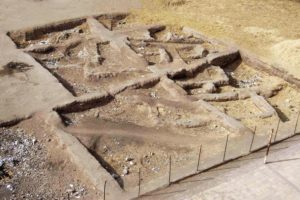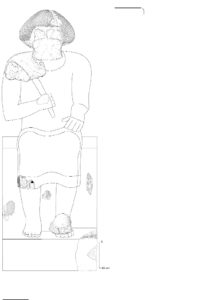By Simcha Jacobovici, also known by his TV show "The Naked Archaeologist".
 Interestingly, the Egyptian authorities seem to believe that the statue is, indeed, related to the Hebrew Bible. Some years back, when I was in Egypt filming “The Exodus: Decoded”, I asked to film Prof. Bietak’s find. The Egyptian authorities don’t like archeology that confirms the Hebrew Bible, so they told me that the statue has been “misplaced”. Since the artifact weighs a whole lot, this is not something that you can easily “misplace”.
Interestingly, the Egyptian authorities seem to believe that the statue is, indeed, related to the Hebrew Bible. Some years back, when I was in Egypt filming “The Exodus: Decoded”, I asked to film Prof. Bietak’s find. The Egyptian authorities don’t like archeology that confirms the Hebrew Bible, so they told me that the statue has been “misplaced”. Since the artifact weighs a whole lot, this is not something that you can easily “misplace”.
Simcha Jacobovici Simcha Jacobovici is a Canadian-Israeli filmmaker and journalist. He is a three-times Emmy winner for “Outstanding Investigative Journalism” and a … [More]
Is there archeological evidence for the Biblical Joseph? If you misdate the Biblical Exodus i.e., if you put the Exodus into a historical context where it does not belong, then – by definition – you won’t find any archeological evidence for Joseph, or any other Biblical figure for that matter. And this is precisely what the majority of archeologists do when they date the Exodus. First, they say it didn’t happen. Then, they illogically date what didn’t happen to the 13th century BCE – 1270 BCE to be precise.
But if you go with the date for the Exodus proposed by the Bible itself i.e., 480 years prior to the construction of the Temple of Solomon (1 Kings 6:1), then you get a date around 1,500 BCE. Based on archeology and textual analysis, professors John Bimson and the late David Livingston proposed a similar date.
So let’s go with the Biblical chronology and see if it leads us to any archeology connected to the Israelite patriarch Joseph, of “multicoloured” coat fame:
According to the Torah (the Five Books of Moses), the Israelite stay in Egypt was 430 years (Exodus 12:40). According to the Talmud, the ancient Rabbinic text, it was only 215 years (Pirkei Rabbi Elieser, c.48). Based on the lifespans of the Israelite generations that came into and left Egypt, the 215 years make more sense. But another way to look at it is that there were two groups that left Egypt during the Biblical Exodus – one after being in Egypt for 430 years, and the other after being there for 215 years.
Do history and archeology argue “for” or “against” the idea that there were two groups that left Egypt during the Biblical Exodus? Unquestionably, they argue for. Around the year 1,500 BCE, a Canaanite group that scholars call “Hyksos” and that ancient Egyptians called “Amo” left Egypt in a mass exodus. Scholars call this the “Hyksos Expulsion”. At around the same time, the Bible tells us (in the Hebrew original) that the “Amo Israel” i.e., the Israelites, followed Moses to the Promised Land.
In this week’s Torah portion, “Ki Tisa”, we have the story of the “Am” that created the golden calf. These seem to be the so-called “Hyksos”. Theirs was a direct challenge to Moses’ leadership and to his Israelite kin (Exodus 30:11-34:35). The Hyksos counter-revolution was only put down after some 3,000 rebels were killed by Moses and his Levite family militia (Exodus 32:28). In any event, the Biblical story clearly implies that there were two groups that left Egypt i.e., the pro and anti Moses camps. This is an important point because the evidence for the Biblical Exodus may be hiding behind Hyksos archeology.
When the Torah records that the original Israelites travelled to the Egyptian Delta because of a famine, it seems that there was a Canaanitish population i.e., the Hyksos, already there. In Genesis 41:44, Jacob’s son, Joseph, becomes Pharaoh-like i.e., second in command to the Egyptian Pharaoh. If the Talmudic estimate of the Israelite presence in Egypt is correct, Joseph’s rise to power took place around 1,700 BCE. If Joseph was indeed a Pharaoh like figure, who ruled both Israelites and Hyksos, one would think that there would be some kind of archeological relic attesting to his reign. And there is.
Prof Manfred Bietak has been digging at Tell el-Dab’a in Egypt for over 40 years. He has identified it as “Avaris”, the ancient Hyksos capital. Avaris is smack dab in the middle of the area the Bible calls “Goshen” i.e., the area that the Israelites lived in prior to the Exodus. The word “Avaris” means nothing in Egyptian. But, in the Torah, Joseph is repeatedly called a “Hebrew”; “Ivri” in the Hebrew language. He is also repeatedly and curiously called “Ha Ish”; “The Man”. In other words, the word “Avaris” may very well be related to Joseph, the “Ish Ivri”, or the “Hebrew Man” (Genesis 39:14). All this is lost in translation when Joseph is simply called a “Hebrew”. Put differently, the so-called Hyksos capital seems to be named after Joseph the “Ish Ivri” i.e., Avar-Ish.
Between 1986 and 1988, Prof. Bietak found the remains of a monumental statue that seems to have belonged to a non-Egyptian ruler of Avaris. Although only fragments remain, the archeologists estimate the original size of the seated figure to be 2 meters high and 1.5 meters in depth i.e., about one and a half times life size. Over the statue’s right shoulder you can still see his “throw stick” i.e., the symbol of his rule. On the back – remarkably, as with the Biblical Joseph – you can still see evidence that this ruler was wearing a striped garment, made up of at least three colors: black, red and white. He was found in a tomb. The tomb was empty. This may be as a result of looting, but one can’t help but recall that the Biblical narrative explicitly tells us that when the Israelites left on the Exodus, they took Joseph’s bones with them (Exodus 13:19). In other words, in order to fit with the Biblical narrative, any tomb of Joseph in Egypt would have to be empty.
They call the statue the “Asiatic” i.e., he is not Egyptian, rather he is a man who comes from the area of Canaan/Israel. They might as well call him the “Ish Ivri”. Not much is left of his face because after his rule, as with the Biblical Joseph, his people seem to have experienced a downfall. Put differently, someone in ancient times took a hammer to his face. But his hairdo is still intact. They call it a “mushroom” hairdo and it’s specifically related to non-Egyptians from the area of ancient Canaan/Israel. Interestingly, it’s quite the “do”, and the Talmud goes out of its way to tell us that Joseph was quite the fashionista (Genesis Rabbah, 87:3). In fact, the Rabbinic Midrash Tanhuma Vayyesheb 8 specifically talks about Joseph curling his hair.
The statue was found in a layer corresponding to the year c. 1,700 BCE. In other words, if we take 1,500 BCE as the date for the Exodus, and if the Israelite sojourn in Egypt was around 200 years, the statue of this ruler perfectly fits the story of the Biblical Joseph who ruled around 215 years prior to the Exodus.
Of course it’s conjecture but, based on the evidence, I think we can say that Joseph’s statue may very well have been found in Egypt. Why hasn’t anyone noticed? Because historians hide – consciously or unconsciously – Israelite/Jewish history behind terms like “Hyksos,” “Asiatics,” and “Amo”.
Interestingly, the Egyptian authorities seem to believe that the statue is, indeed, related to the Hebrew Bible. Some years back, when I was in Egypt filming “The Exodus: Decoded”, I asked to film Prof. Bietak’s find. The Egyptian authorities don’t like archeology that confirms the Hebrew Bible, so they told me that the statue has been “misplaced”. Since the artifact weighs a whole lot, this is not something that you can easily “misplace”.
It seems the Egyptians also believe that what they’re hiding in the bowels of the Cairo Museum is the only monument of Joseph ever found.
Source - http://blogs.timesofisrael.com/statue-of-biblical-joseph-found-story-covered-up/
RELATED
Biblical Joseph's ring found -
http://blogs.timesofisrael.com/biblical-josephs-ring-found/
RELATED
Biblical Joseph's ring found -
http://blogs.timesofisrael.com/biblical-josephs-ring-found/
Author's blog - http://blogs.timesofisrael.com/author/simcha-jacobovici/
Episodes of Simcha Jacobovici's film series on YouTube
https://www.youtube.com/playlist?list=PLhO1Dlt7lhIY9ZnMsyy7oRXVAKiCGXNUn
Episodes of Simcha Jacobovici's film series on YouTube
https://www.youtube.com/playlist?list=PLhO1Dlt7lhIY9ZnMsyy7oRXVAKiCGXNUn


No comments:
Post a Comment
Thank you for visiting my blog. Your comments are always appreciated, but please do not include links.